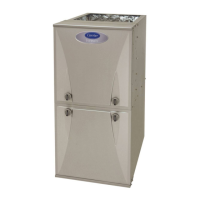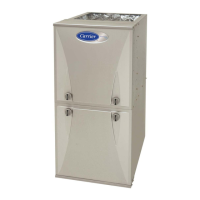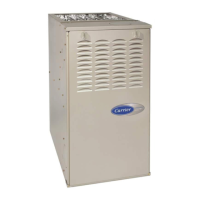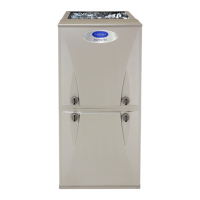Do you have a question about the Carrier PG92MSAA36060A and is the answer not in the manual?
Specifies requirements for CO detector installation for side wall vented gas equipment.
Details standards CO detectors must meet (NFPA 720, ANSI/UL 2034).
Warns about CO poisoning, emphasizing installation, maintenance, and service instructions.
Warns against using non-manufacturer approved parts and accessories for safety and reliability.
Warns against bypassing safety controls like limit switches or thermal switches.
Details requirements for ventilated combustion air applications.
Lists US and Canadian safety codes applicable to furnace installation.
Specifies codes related to combustion and ventilation air requirements.
Warns about improper use or installation leading to premature component failure.
Details requirements for providing outdoor air for combustion, ventilation, and dilution.
Explains that the condensate trap does not need relocation for upflow orientation.
Details how to relocate the condensate trap for downflow installation.
Warns that plugged drains or failed pumps can cause furnace shutdown.
Warns against operating without a filter or with access doors removed.
Warns against using aluminum wire for electrical connections to the furnace.
Warns about high voltage field connections and proper use of J-box or external box.
General safety warnings for wiring and control routing.
General safety warnings regarding modification of the product.
Describes requirements for direct-vent systems where air is taken from outdoors.
Details requirements for ventilated combustion air systems, including termination and air supply.
Describes requirements for non-direct vent systems where air is taken from adjacent areas.
Explains how to calculate Total Equivalent Vent Length (TEVL) considering pipe length and fittings.
Section on furnace control programming and navigation.
Introduces the furnace control's LCD display and pushbutton interface for adjustments.
Explains how to navigate the control menu and adjust parameters.
Warns about hazards when accessing the furnace control.
Warns against improper operation or failure to reset the limit switch.
Lists critical steps to follow for proper installation and start-up to avoid issues.
Warns about CO poisoning from improperly configured or unprimed condensate traps.
Cautions against redrilling orifices, as it can cause noise and heat exchanger damage.
Warns about tightening the set screw and installing the pipe plug to prevent gas leaks.
Advises rechecking temperature rise and recommended operation points.
Details how to test the main limit switch for proper operation during overheat conditions.
Explains how to test the pressure switch for proper draft inducer blower operation.
Covers electrical controls and wiring.
Warns about electrical hazards during servicing and the importance of proper grounding.
Warns about storing flammable materials near the furnace.
Warns against operating without a filter or with access doors removed.
Details how to clean or replace the furnace air filter.
Warns to turn off gas and electrical supplies and use lockout tags before servicing.
Explains how to clean primary heat exchangers and when replacement is necessary.
Warning section.
Warns to turn off gas and electrical supplies and use lockout tags before maintenance.
Warns about potential unit or property damage if furnace is not winterized in cold spaces.
Cautions against using automotive antifreeze, which can damage plastic components.
Section for recording gas adjustment parameters like heat content, specific gravity, and manifold pressure.
Details how to calculate or find the furnace firing rate based on gas properties.
Specifies requirements for CO detector installation for side wall vented gas equipment.
Details standards CO detectors must meet (NFPA 720, ANSI/UL 2034).
Warns about CO poisoning, emphasizing installation, maintenance, and service instructions.
Warns against using non-manufacturer approved parts and accessories for safety and reliability.
Warns against bypassing safety controls like limit switches or thermal switches.
Details requirements for ventilated combustion air applications.
Lists US and Canadian safety codes applicable to furnace installation.
Specifies codes related to combustion and ventilation air requirements.
Warns about improper use or installation leading to premature component failure.
Details requirements for providing outdoor air for combustion, ventilation, and dilution.
Explains that the condensate trap does not need relocation for upflow orientation.
Details how to relocate the condensate trap for downflow installation.
Warns that plugged drains or failed pumps can cause furnace shutdown.
Warns against operating without a filter or with access doors removed.
Warns against using aluminum wire for electrical connections to the furnace.
Warns about high voltage field connections and proper use of J-box or external box.
General safety warnings for wiring and control routing.
General safety warnings regarding modification of the product.
Describes requirements for direct-vent systems where air is taken from outdoors.
Details requirements for ventilated combustion air systems, including termination and air supply.
Describes requirements for non-direct vent systems where air is taken from adjacent areas.
Explains how to calculate Total Equivalent Vent Length (TEVL) considering pipe length and fittings.
Section on furnace control programming and navigation.
Introduces the furnace control's LCD display and pushbutton interface for adjustments.
Explains how to navigate the control menu and adjust parameters.
Warns about hazards when accessing the furnace control.
Warns against improper operation or failure to reset the limit switch.
Lists critical steps to follow for proper installation and start-up to avoid issues.
Warns about CO poisoning from improperly configured or unprimed condensate traps.
Cautions against redrilling orifices, as it can cause noise and heat exchanger damage.
Warns about tightening the set screw and installing the pipe plug to prevent gas leaks.
Advises rechecking temperature rise and recommended operation points.
Details how to test the main limit switch for proper operation during overheat conditions.
Explains how to test the pressure switch for proper draft inducer blower operation.
Covers electrical controls and wiring.
Warns about electrical hazards during servicing and the importance of proper grounding.
Warns about storing flammable materials near the furnace.
Warns against operating without a filter or with access doors removed.
Details how to clean or replace the furnace air filter.
Warns to turn off gas and electrical supplies and use lockout tags before servicing.
Explains how to clean primary heat exchangers and when replacement is necessary.
Warning section.
Warns to turn off gas and electrical supplies and use lockout tags before maintenance.
Warns about potential unit or property damage if furnace is not winterized in cold spaces.
Cautions against using automotive antifreeze, which can damage plastic components.
Section for recording gas adjustment parameters like heat content, specific gravity, and manifold pressure.
Details how to calculate or find the furnace firing rate based on gas properties.
| Model | PG92MSAA36060A |
|---|---|
| Type | Gas Furnace |
| Heating Capacity | 60, 000 BTU |
| Fuel Type | Natural Gas |
| AFUE | 92% |
| Heating Stages | Two-Stage |
| BTU Input | 60, 000 |
| Brand | Carrier |
| Model Number | PG92MSAA36060A |
| Input BTU | 60, 000 BTU |
| Output BTU | 55, 200 BTU |
| Stages | 2 |
| Ignition Type | Hot Surface Ignition |
| Heat Exchanger Material | Stainless Steel |
| Efficiency Rating | 92% AFUE |
| Warranty | 10 Years |












